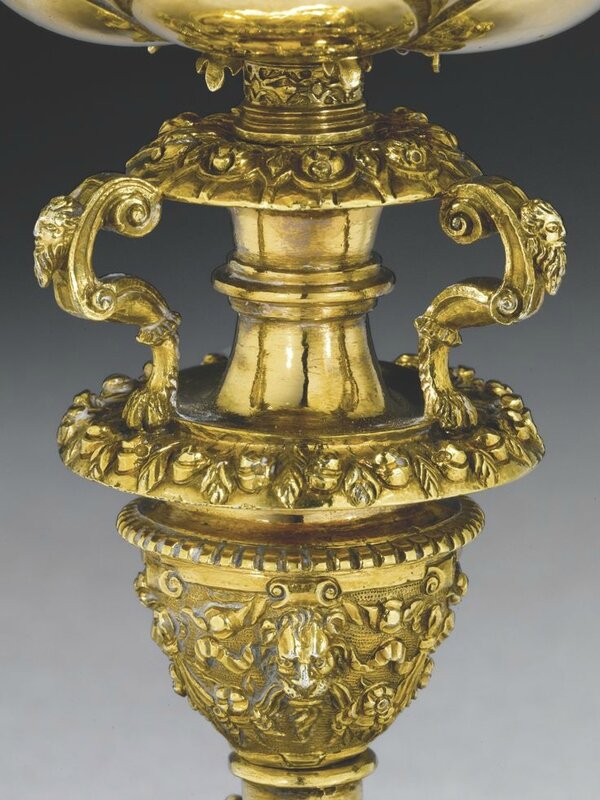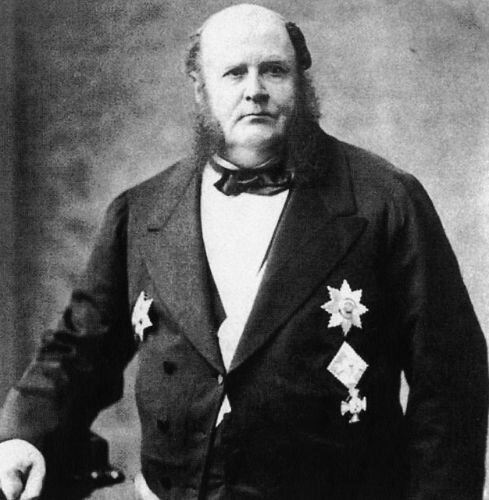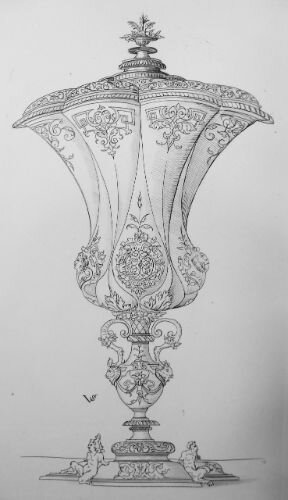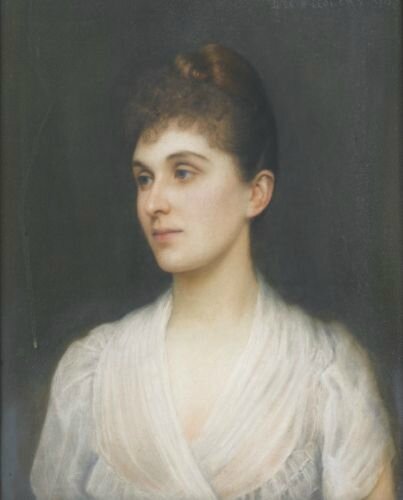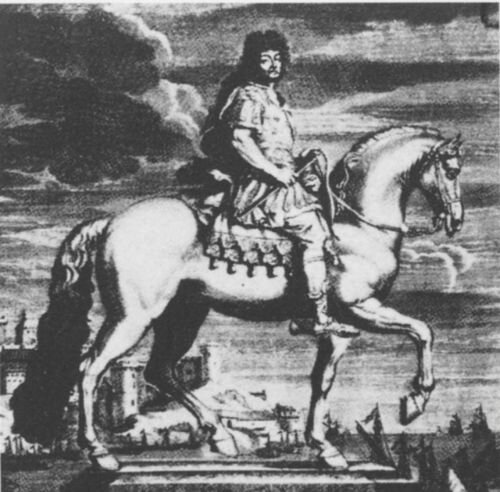![3]()
![4]()
![5]()
A blue and white kendi with German silver-gilt mounts, the porcelain Ming Dynasty, Wanli Period (1572-1620), the mounts unmarked, probably Augsburg or Nuremberg, early 17th century. Estimate 200,000 — 300,000 GBP. Lot. Sold 245,000 GBP. Photo Sotheby's.
the lobed compressed spherical body rising from a flat base, to a tall cylindrical neck, painted with roundels of a horse, crane and lion below a wide band of peony and chrysanthemum at the shoulder, the ribbed domed spout with various diaper panels, each bordered with an antler motif, with further roundels to the top of the neck, below a band of key-fret at the mouth, the subtly matted silver-gilt mounts echoing the antler motifs and flowers and incorporating bats' wings with entwined strapwork and a grotesque mask with lobate jowls and winged ears; 22.5cm., 9in. high
Provenance: The Dukes of Trachenberg, Princes of Hatzfeldt. Formerly Schloss Trachenberg, Silesia
Exhibition: Ausstellung von Goldschmiedearbeiten schlesischen Ursprunges oder aus schlesischem Besitze, Breslau, 1905, no. 816
Bibliography: Erwin Hintze; Karl Masner, Goldschmiedearbeiten Schlesiens; eine Auswahl von Goldschmiedearbeiten schlesischer Herkunft oder aus schlesischem Besitze, Breslau, 1911, p. 39 no. LXIIV. Illustrated with silver-gilt cover and spout mount (now lacking)
D.F Lunsingh Scheurleer, Chinesisches und Japanisches Porzellan in Europäischen Fassungen, Brunswick, 1980, p. 192
Associated Literature:
Jens Friedhoff, Schloss Trachenberg (Zmigrod) in Niederschlesien. Anmerkungen zur Baugeschichte und Ausstattung, in: Burgen und Schlösser 41 (2000), vol.2 , p. 66-83
Jens Friedhoff, Die Familie von Hatzfeldt, Adelige Wohnkultur und Lebensführung zwischen Renaissance und Barock (Vereinigte Adelsarchive im Rheinland e.V., Schriften, Bd. 1), Düsseldorf, 2004
Note: Striking for its meticulously painted cobalt blue decoration, kendi of this lobed form and design are extremely unusual, and no other closely related example appears to have been published. Blue and white kendi were produced exclusively for export to the Middle East and Southeast Asia, although a small number found their way to Europe. Blue and white wares of this type were produced at non-official kilns in Jingdezhen, Jiangxi province, which were not under strict Imperial supervision. As a result some innovative and original designs were created, as exemplified by this piece. Of particular note are the four different geometric patterns that decorate the spout, the playful rendering of the animal roundels on the body, and the lush flower blooms and leaves on the shoulders.
Compare a slightly smaller kendi of similar lobed form, painted with flower sprays, from the F. Lugt collection and now in the Institut Néerlandais, Paris.1
Chinese porcelain was an exotic and valuable material in the West. It had properties which were unknown to European science;2 it was hard, translucent, impervious to liquid and coming from an exotic land, far away, was, in the early days at least, very difficult to acquire. It was given powers, which like ‘Unicorn horn’ (Narwal) and ‘Serpents’ tongues’ (fossilized sharks’ teeth) could warn of poison or act as an antidote to it.3 No wonder its owners embellished it with precious mounts. In Giovanni Bellini’s ‘The Feast of the Gods’ (National Museum of Washington) painted for a member of the D’Este family in 1514, a parcel-gilt silver beaker and cover lie on the ground while a satyr carries in a Chinese blue and white bowl with silver-gilt handle and strap. Chinese porcelain was still a royal gift towards the end of the 16th Century; Robert Burghley presented Queen Elizabeth I with a gold-mounted bowl in 1587, and a ewer owned by Burghley or his son Robert Cecil with silver-gilt mounts dated 1585 is in the Metropolitan Museum of Art, New York.4
Kendi, which were made for the Middle Eastern market and designed for pouring directly into the mouth, appear in a few European paintings from the early 17th Century. An un-mounted example was used by Jan Breughel the elder on at least two occasions including his 1617 allegory of ‘Sight’ in the Prado (acquisition no. po 1394).5 It is visible behind a hardstone cup, part of the Kunstkammer objects of the Habsburg archduke Alberto VII (1559-1621) and his co-Sovereign Clara Eugenia of Spain (1566-1630). An example with silver mounts appears in a painting dated 1615 by Nicolaes Gillis.6 An even more elaborately mounted kendi, is in a painting by Pieter Roestraten (1630-1700).7 (see detail). The handful of mounted examples that have survived,8 have mostly rather plain white mounts of English make. These mounts include a spout in the form of an animal’s head but are otherwise, with the exception of the Boston example, linear and functional. Unlike those, the current example has silver-gilt mounts which are inventive and complimentary to the Chinese ornament. They are likely to have come from a main centre such as Augsburg or Nuremberg where the skills existed and the goldsmiths were leaders in the current style. Items with Nuremberg mounts, formerly belonging to the princes of Hatzfeldt, and exhibited together with the kendi in 1905, are now in the Thyssen-Bornemisza collection and the Metropolitan Museum of Art.9 The latter item, the silver base and mount of a cup, by Wolf Christof Ritter of Nuremberg, is like the mounts of the kendi, in lobate style.
![6]()
Pieter Gerritsz van Roestraten, Nature morte. © Sotheby’s London, 2 July 1985, lot 165
The kendi and three other items can be identified in the portrait of Marie, Fürstin von Hatzfeldt (1820-1897), who is seated in a magnificent dress in front of a desk, arranged with family treasures (see following page). On the Fürstin’s right, next to a small marble bust is a carved smoky quartz cup with silver-gilt mounts; to her left below the kendi is a carved rock crystal cup with gold mounts, probably of the Miseroni workshop,10 and also on her left, behind the candlestick, a rock crystal bowl from the Miseroni workshop with gold mounts, given to the cavalry captain and future general field marshal Melchior von Hatzfeldt (1593-1658) by Adolf von Schleswig-Holstein-Gottorf (1600-1631). This became a gift from J. Pierpont Morgan to the Metropolitan Museum of Art, New York (acquisition no. 17.190.544).
![9]()
Anton Weber, Marie Fürstin v. Hatzfeldt (née von Nimpsch, 1820-1897), Schloss Trachenberg, Silesia, circa 1876. © Private collection. The Kendi is visible on Fürstin’s left.
![10]()
A smoky quartz cup with silver mounts, early 17th century.© Sotheby’s Amsterdam, 17th December 2008, lot 255.
![11]()
Two-handled cup, rock crystal and enamelled gold, gift of J. Pierpont Morgan. © 2015. The Metropolitan Museum of Art/Art Resource/Scala, Florence
Despite the limited descriptions of objects in the Hatzfeldt family’s early inventories these three items can be identified in family papers with some confidence from 163411 when the collection was stored in the ‘Hatzfelder Hof’ in Cologne during the Thirty Years’ War. This is where Franz von Hatzfeldt (1596-1642), Prince-Bishop of Würzburg (1631) and of Bamberg (1633) had taken refuge from enemy forces since 1631. These three items are then more obviously in the inventories of 1641,12 still in Cologne, and 1673/74,13 the latter being drawn up following the death of Hermann von Hatzfeldt-Crottorf-Gleichen (1603-1673), the Prince Bishop’s brother.
The earliest inventories also include silver and silver-gilt mounted porcelain items, but it cannot be stated for certain, due to the limited descriptions, that the kendi, is one of these. As the kendi was included in the portrait of the Fürstin made at Schloss Trachenberg in 1876, it can probably be identified from the inventory taken only six years earlier, of items belonging to an Entailed Estate at Schloss Trachenberg , as one of 2 porcelain jugs mounted with silver-gilt and valued at 40 Thalers.14No other reference to silver-gilt mounted porcelain in that inventory is possible. These two porcelain jugs with silver-gilt mounts can be traced back through an earlier inventory of 1779 which also records them as part of the Entailed estate (Majorat) of the Hatzfeldt family, and possibly 1722 where they are recorded at Schloss Crottorf, the ancestral seat of the family. The Majorat was set up in 1662 by Hermann Graf von Hatzfeldt (1603-1673) and ratified by the emperor in 1668. It stipulated that the freie Standesherrschaft Trachenberg, and certain Hatzfeldt property, should always stay with the family. When Hermann Hatzfeldt’s great-great-grandson, Friedrich Karl Franz Cajetan Fürst von Hatzfeldt-Trachenberg (1779-1794) died without issue, Trachenberg together with most of the entailed estate devolved onto the branch of the family Hatzfeldt-Werther-Schönstein headed by Franz Ludwig von Hatzfeldt (1756-1827) who received the Prussian title of a Prince in 1803. Franz Ludwig’s daughter-in-law was Fürstin Marie (1820-1897) who features in the portrait. Not all objects belonging to the Entailed estate are known but some of them such as the mounted hardstone cups in the portrait of Fürstin Hatzfeldt, can be identified from the 1779 inventory.15 As the two porcelain jugs (one of which is probably the kendi), are also recorded in the 1779 inventory as part of the Entail it is possible that they also entered the family collection before 1722.
1. Maura Rinaldi, Kraak Porcelain. A Moment in the History of Trade, London, 1989, pl. 221
2. In 1512 the Portuguese Duarte Barbarosa wrote that it was made ‘from the shells of fish ground fine, from eggshells and white of eggs and other materials…’ Jean Michel Massing, ‘From Marco Polo to Manuel I’, in Encompassing the Globe, Portugal and the World in the 16th and 17th Centuries, the Essays, Washington, 2007, p. 228
3. Op. cit. p.228. In an inventory of 1532, Chinese porcelain is described as `So sound that if some evil people should soil it with poison to harm anybody it would instantly break of itself and fall into pieces rather than tolerate the evil beverage which was meant to injure our inside’
4. Timothy Schroder, Renaissance and Baroque Silver, Mounted Porcelain and Ruby glass from the Zilkha Collection, London, 2012, p. 220
5. Dr. A.I. Spriggs, Oriental Porcelain in Western Paintings 1450-1700, Transactions of the Oriental Ceramic Society, vol. 36 (1964-6), p. 78
6. Op.cit. p 78
7. Pieter Gerritsz van Roestraten (circa 1630-1692) Nature morte, oil on canvas. Sold Sothebys London, 2 July 1985, lot 165
8. Museum of Fine Arts, Boston, (55.471) probably English mounts, circa 1610; Victoria and Albert Museum, London, (M220-1916) maker’s mark RP with an escallop, English, late 16th century; The Art Institute of Chicago, ( 1966.133) English mounts, circa 1610; Topkapi Museum, Turkish mounts (TKS 7809), late 16th century
9. Hannelore Müller, The Thyssen-Bornemisza Collection, European Silver, London, 1986, no 54; Metropolitan Museum of Art, New York, Accession no. 17.190.630
10. The smoky quartz cup was sold Sothebys Amsterdam, 17 December, 2008 lot 255; the rock crystal cup was sold Lempertz, sale no. 928, 20. November 2008, lot 1015.
11. ‘Specification verscheidener [sic] Altfrenkischer Geschier und Antiquiteten so den 18ten 7brs. 1634 in den Schanck im gewölb eingesetzt worden.
Erstlich ein groß Cristallen geschir, ungefehr 2 Maß haltendt.
It. ein Cristallen drinckgeschier in golt eingefast.
Noch ein Tranckgeschir von Dupasio in golt eingefast
Noch zwey geschir von Cristall in golt gefast.‘
Verzeichnisse ueber gräfl. Hatzfeldsches Gold- und Silbergeschirr, und Bücher de anno 1634 et 1684
(Archiwum Panstwowe Wroclaw, Archivum Hatzfeldtów Nr. 909, p. 6).
12. ‘1 Cristallen geschier, in goldt eingefast, mit gulden Handthaben, vom Hertzogen von Holstein.’
(the Holstein-rock crystal cup, Metropolitan Museum New York)
‘1 gantz dunkel braun geschier von Tupasio in golt gefast, mit rubinen versezt, in einem roten futerall.’
(the smoky quartz cup)
Inventaria und Consignationes über Jouvelen, Silberwerk, Praetiosa, Meubles und Schriften der Hatzfeldischen Familie gehörig 1641 – 1661
(Archiwum Panstwowe Wroclaw, Archivum Hatzfeldtów Nr. 911, p. 6).
13. `Ein dickhe geschnittene Crystallene Trinckhschalen, am Fueß mit einem güldenen Reyff, undt unden ahn deß Fueßranffts mit golt eingefast in einem schwartz ledernem Futral’ (the Lempertz rock crystal cup).
Inventarium über Des Hochgebohrnen Herrn Graffen Hermanns von Hatzfeld und Gleichen Verlassenschaft zu Blanckenhain, Würtzburg und Trachenberg de Annis 1673 et 1674
(Landeshauptarchiv Koblenz, Bestand 56 Nr. 1070, III, Q 47 – 57, Nr. 55, Fol. 49).
14. ‘Titel VI. An Uhren, Tabatieren und anderen kleinen kostbaren oder künstlichen Stücken.
A. An vergoldetem Silber
Zwei weiß und blau porzellaine Krüge mit vergoldetem Silber beschlagen. 40 Thaler’ (Two white and blue porcelain jugs mounted with silver-gilt. 40 Thaler value)
Nachweis derjenigen Veränderungen welche seit dem Inkrafttreten des Allerhöchst am 19tn März 1870 bestätigten Familienschlusses bei der Substanz des Fideicommiss-Fürstenthums Trachenberg und bei dem zugehörigen Fideicommiss-Inventarium bis zum 30tn September 1876 vorgekommen sind
(Archiwum Panstwowe Wroclaw, Archivum Hatzfeldtów No. 3273, p. 25).
15. Inventaria über den sämtlichen Nachlaß des abgelebten Herrrn Fürsten von Hatzfeld De Anno 1779 (Archiwum Panstwowe Wroclaw, Archivum Hatzfeldtów Nr. 835, p.66-69):
A number of other items from the Entail have been identified, which include:
A Fayence Jug dated 1610, with silver-gilt mounts. First mentioned in a Hatzfeldt inventory of 1634 (probably) and certainly in 1641. Sold Dorotheum, 16.10. 2008, lot 1101.
An elephant tusk with gold mounts, mid-16th century, coming from the von Thüngen family. First Hatzfeldt inventory 1673/74. Sold Sothebys, Amsterdam 17 December 2008, lot 258.
A Rhinoceros Horn cup, with German silver-gilt mounts. First Hatzfeldt inventory 1634 when it was unmounted. Second Hatzfeldt inventory of 1641 when it had silver-gilt mounts and a round case. Fourth Hatzfeldt inventory of 1779 when it was recorded with the onyx appliques. “10. ein Geschirr von Rhinoceros mit Silber vergoldt eingefaßt, worauf sieben geschnittene Onix steine sind. Da einer davon in ein Ring gefasst worden, so gehört dieser Ring gleichfalls zum Majorate.‘ (A dish of rhinoceros mounted with silver gilt, applied with seven cut onyx stones. As one stone was mounted in a ring the ring also belongs to the Entailed estate). Sold to Eugen von Gutmann 1912. Acquired by Baron Heinrich Thyssen-Bornemisza (1875-1947). See Hannelore Müller, The Thyssen-Bornemisza Collection, London, 1986, no.54
A rock crystal cross with gold and enamel mounting set with pearls and precious stones, probably Milan, end 16th/beginning 17th century, sold Lempertz, sale no. 928, 20. November 2008, lot 1012. Listed in the inventory of 1634 as “Erstlich ein Crucifix von Golt undt Cristallen mit Perlein undt Rubinen versetzt pro 800 Rthlr.’
Sotheby's. Treasures, 08 juillet 2015 | 5:30 PM BST - Londres


























